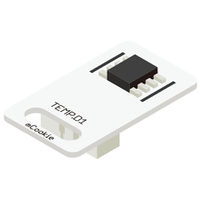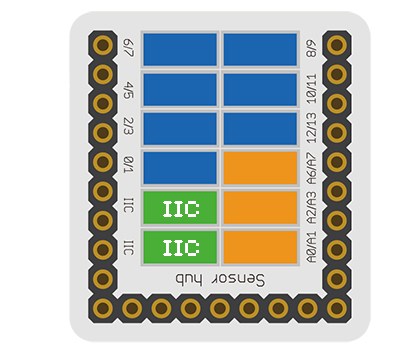Difference between revisions of "Sensor-Temperature-D1"
From Microduino Wiki
(→Program) |
|||
| Line 1: | Line 1: | ||
| − | {{Language| | + | {{Language|Sensor-LM75}} |
{| style="width: 800px;" | {| style="width: 800px;" | ||
|- | |- | ||
| | | | ||
| − | [[File: Microduino-LM75.jpg|400px|thumb|right| Microduino- | + | [[File: Microduino-LM75.jpg|400px|thumb|right| Microduino-Sensor-Temperature-D1]] |
| + | The product number of Sensor-Temperature-D1 is: MSDT11 | ||
| − | + | Sensor-Temperature-D1 is digital temperature detection sensor module. | |
| + | LM75 is a temperature sensor produced by National Semiconductor whose output voltage is of Celsius scale. | ||
| − | + | ==Introduction of the Sensor Pin== | |
| − | |||
| − | |||
| − | |||
| − | == | ||
{{Sensor_explain | {{Sensor_explain | ||
|nameA=[[Sensor-Temperature-D1]] | |nameA=[[Sensor-Temperature-D1]] | ||
| Line 23: | Line 21: | ||
*With low power consumption, long service life and good stability. | *With low power consumption, long service life and good stability. | ||
*With wide working voltage. | *With wide working voltage. | ||
| − | *With small size which is easy to install. | + | *With small size which is easy to install. |
==Specification== | ==Specification== | ||
| − | * | + | *Sensor voltage |
| − | ** | + | **3.3V~5V working voltage |
| − | ** | + | |
| + | *Size of the sensor | ||
| + | **Size of the board: 23.5mm*13mm | ||
| + | **1.27mm-spacing 4Pin interface connected with sensorhub | ||
| + | **CAD drawing of the sensor: '''[[File:Sensor_CAD.zip]]''' | ||
| + | |||
*Technical parameters | *Technical parameters | ||
| − | *Accuracy: temperature 0.125℃ | + | **Accuracy: temperature 0.125℃; |
| − | * | + | **Measuring range: 55℃~+125℃; |
| − | + | ||
| − | |||
| − | |||
| − | |||
*Connection | *Connection | ||
| − | * | + | *This sensor can e connected to the I2C interface of the core. |
| − | |||
| − | |||
| − | |||
==Document== | ==Document== | ||
| − | *Schematic diagram: '''[[File: | + | *Schematic diagram: '''[[File: Sensor_Temperature_D1.Zip]]''' |
| − | |||
==Development== | ==Development== | ||
| − | === | + | ===Program Download=== |
| − | * | + | *Download and unzip the program '''[[File:Sensor_Temperature_D1_Test.zip]]''' |
| − | |||
| − | |||
| − | |||
| − | + | ===Programming=== | |
| − | === | + | {{Upload |
| − | + | |nameA=[[Microduino-Core]], [[Microduino-USBTTL]] | |
| − | [[ | + | |nameB=[[Microduino-USBTTL]] |
| − | + | |boardName=Microduino/mCookie-Core(328p), Atmega328P@16M,5V | |
| − | + | |fileName=Sensor_Temperature_D1_Test.ino | |
| − | + | }} | |
| − | |||
===Hardware Setup=== | ===Hardware Setup=== | ||
| − | * | + | *Referring to the following diagram, connect the Sensor-Temperature-D1 to theI2C interface of '''[[Microduino-Sensorhub]]'''. |
| − | [[Microduino-Sensorhub]] | + | <br> |
| − | [[file:Microduino-sensorhub_I2C. | + | [[file:Microduino-sensorhub_I2C.JPG|thumb|400px|left]] |
| − | + | <br style="clear: left"/> | |
| − | + | ===Result=== | |
| − | + | *After download, open the serial monitor. | |
| − | * | + | *The serial monitor will print out the configuration information of the sensor, and then display the current temperature in cycle. |
| − | |||
| − | |||
| − | |||
| − | * | ||
==Application== | ==Application== | ||
| − | It can be | + | It can be sued to detect the humidity of the environment, and be sued as temperature switch to control the air conditioner, fan and other devices. |
Revision as of 06:25, 19 September 2016
| Language: | English • 中文 |
|---|
|
The product number of Sensor-Temperature-D1 is: MSDT11 Sensor-Temperature-D1 is digital temperature detection sensor module. LM75 is a temperature sensor produced by National Semiconductor whose output voltage is of Celsius scale. Contents[hide]Introduction of the Sensor Pin
Features
Specification
Document
DevelopmentProgram Download
Programming
Hardware Setup
Result
ApplicationIt can be sued to detect the humidity of the environment, and be sued as temperature switch to control the air conditioner, fan and other devices.
PurchaseHistoryGallery
|




